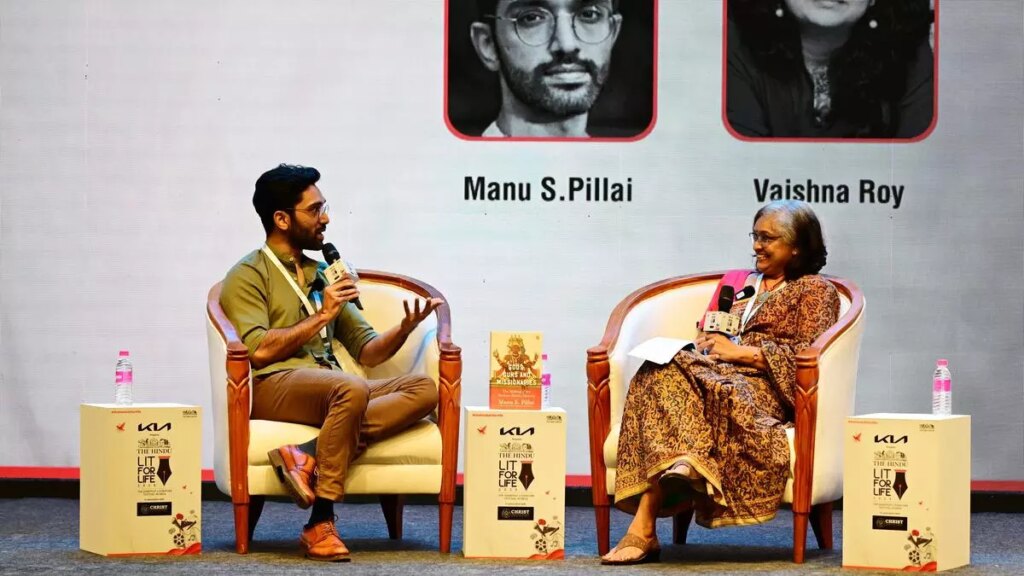
Manu Pillai in conversation with Vaishna Roy at The Hindu Lit for Life festival 2025 held at Sir Mutha Concert Hall in Chennai on January 19.
| Photo Credit: VELANKANNI RAJ B
“The ease and enthusiasm with which Hindus in India were able to appropriate that term [Hinduism] shows that they already had a sense that they had this value. It’s just that the term could be applied there very easily,” said historian Manu Pillai during an insightful discussion about his latest book Gods, Guns and Missionaries at the Hindu Lit for Life 2025 festival in Chennai on January 19.
The conversation, which took place at Sir Mutha Concert Hall in Chennai on January 19, featured Pillai in conversation with Frontline’s Editor Vaishna Roy. The session also marked Frontline magazine’s 40th anniversary celebration.
Pillai challenged the academic notion that Hinduism was merely an invention of British East India Company chairman and politician Charles Grant during the Raj. He pointed out how Indians exercised agency in shaping their religious identity. While the British may have coined the term Hinduism, Indians readily embraced and adapted it to their existing spiritual framework, noted Pillai.
Also Read | Homogeneity is alien to Hinduism: Manu S. Pillai
Drawing from personal experiences, Pillai illustrated the fluid nature of Hindu practices. He described his ancestral temple in Kerala, which houses a fascinating array of deities – from the forest goddess Vanadurga who must be exposed to the elements, to Bhadrakali who requires a roof, alongside tribal deities and Naga devatas. This single temple, he explained, proves how Hinduism accommodates diverse traditions and evolves over time.
The historian shared a charming modern example: the “Munch Murugan” temple in Alappuzha where devotees offer “Munch” brand of chocolates to the deity. “People weigh themselves in Munch and donate the Munch to the deity. There are garlands made of Munch chocolate,” Pillai noted, showing how religious customs continue to adapt to contemporary life.
Addressing the historical dynamics between different faiths, Pillai explained how Islam came to South India through trade and commerce, taking on localised forms. In Kerala, he pointed out, the oldest mosques architecturally resembled Hindu temples, and the only Muslim royal family followed the matrilineal system, showcasing how religions adapted to local customs.
When discussing the arrival of Christianity, Pillai detailed how early European missionaries like Roberto de Nobili took interesting approaches to evangelisation. In 17th century Madurai, Robert de Nobili wore saffron robes, sat on the floor eating vegetarian meals from plantain leaves, and allowed converted Brahmins to keep wearing their sacred thread with just a small cross attached. He even called the Bible the “5th Vedam” to merge it with local traditions.
The historian explained how British attitudes toward local religions shifted over time. Early East India Company officials actively participated in Hindu rituals, even making donations to temples. However, as pressure grew in Europe following the Enlightenment and Reformation, a new generation of officials withdrew from these practices and developed a racist contempt toward local customs.
Pillai concluded the discussion talking about his decision to end the book with V.D. Savarkar’s death. “The way ideas behave is that even if something doesn’t sell now, it can survive, it can mutate, and it will find the moment when circumstances on the ground have changed and the idea can come back.” He noted the symbolic significance of Savarkar’s portrait being unveiled in Parliament in 2003, opposite Mahatma Gandhi’s, despite their contrasting visions of modern Hinduism.
Also Read | Sea change: How maritime connections enabled ancient India’s global impact
The session also touched on contemporary issues, with Pillai addressing questions about historical research and religious identity. He reassured the audience that while there might be many questionable theories circulating in current times, solid historical research would ultimately prevail through patience and careful examination.
Throughout the discussion, Pillai stressed on how religious identities in India remain fragmented, diverse, and fluid. He illustrated this through examples of how people hold many identities—such as Kerala’s communist voters who also take part in temple rituals, demonstrating how political ideology and religious practice aren’t necessarily opposed to each other in Indian life.
The conversation, part of Frontline’s 40th-anniversary celebrations, reflected the magazine’s commitment to deep, nuanced journalism. Roy noted that the special anniversary issue features 10 essays by eminent writers examining various aspects of Indian society, from public health to agriculture, cinema, and the Constitution.
Source:https://frontline.thehindu.com/news/the-hindu-lit-for-life-2025-frontline-vaishna-roy-gods-guns-missionaries-manu-pillai/article69118977.ece

